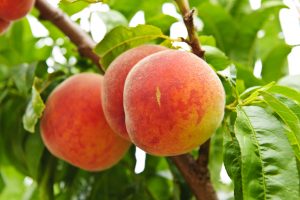By Breanna Kendrick

Tom Beckman, a research horticulturist with the United States Department of Agriculture (USDA) Agricultural Research Service located in Byron, Georgia, is primarily responsible for developing new rootstocks for the Southeastern peach industry. Beckman spoke at the Stone Fruit Field Day in Citra, Florida, about peach diseases and how they influence rootstock development for the Southeast industry. He discussed how problems in peaches differ in the main season production areas in Georgia and South Carolina compared to the early season industry in North and Central Florida, where most of the recent growth in the peach industry has been.
Water logging is an issue for Florida peach growers. “The water will pass through the sandy top soil, but then it will pile up at this relatively impermeable layer that’s out of sight,” says Beckman. “These perched water tables only happen when you have heavy inundations … The trees are literally standing in water, but it’s insidious because you can’t really see it, other than the stress that it puts on the trees.” This is a problem unique to Florida that isn’t often seen in Georgia or South Carolina because those states’ soils are different and the transition from the top soil to the subsoil layer isn’t nearly as restrictive to water movement.
Rootstock development for Florida is a whole different animal than what Beckman has been focused on for the majority of his career. He says without a good rootstock, you can’t get a tree to produce. Florida growers are unfortunately seeing a breakdown of resistance of Flordaguard rootstock to M. floridensis and M. arenaria root-knot nematode species.
“At this point in time, we don’t know if we’re looking at new races we’re encountering for the first time, or if somehow or another, the races that Flordaguard was developed to be resistant to, back in the 80s… have in fact changed somehow to overcome the resistance that Flordaguard provides to their development,” said Beckman. “We’re, in a way, revisiting the entire breeding process for the development of Flordaguard.”
After examining their disease issues and describing what the symptoms look like, Beckman stresses that it’s important that growers know what it is they’re facing. He says he has seen peach tree short life and Armillaria root rot in peaches in Florida, but they’re not common. “A lot of growers have probably never actually seen a tree that was correctly diagnosed as having passed away from either of these problems,” said Beckman.
During his presentation, Beckman shared slides of disease symptoms to show growers what to look for to determine if their trees are dying from peach tree short life, Armillaria root rot, water logging or root-knot nematodes. “It’s important that they know what it is that they’re looking at because the management programs for any of these diseases are quite different,” said Beckman. “Managing Armillaria as if it was short life isn’t going to accomplish very much. Your rootstock selection also differs depending upon the problem(s) you are dealing with. Ideally, we’d have a single rootstock that is resistant to everything but that option is still a ways off.”
Share this Post









